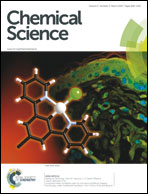Enantioselective synthesis of hexahydrofuro[3,2-c] quinolines through a multicatalytic and multicomponent process. A new “aromatic sandwich” model for BINOL-phosphoric acid catalyzed reactions†
Abstract
A new and straightforward metal–organo orthogonal-relay catalytic asymmetric reaction for the enantioselective synthesis of hexahydrofuro[3,2-c]quinolines is reported. The process involves a three-component coupling reaction between an alkynol, an aldehyde and an arylamine catalyzed by a gold complex and a chiral BINOL-derived phosphoric acid. Quantum chemical calculations of the reaction mechanism suggest that the involved acid-catalyzed Povarov reaction is better described as a sequential Mannich/intramolecular Friedel–Crafts process between the 5-phenyl-2,3-dihydrofuran and protonated N-phenylaldimine reactants generated in situ. Moreover, computations of the reaction mechanisms for the formation of the four stereoisomers of the hexahydrofuro[3,2-c]quinoline adduct using (R)-TRIP-suggested a rationale for the face selectivity of the asymmetric Povarov cycloaddition. With a single coordination mode by ion pairing of the chiral phosphoric acid and the imine, the preferred approach of 5-phenyl-2,3-dihydrofuran to the iminium ion results from a combination of more favourable π-stacking and reduced steric interactions in the Re-exo transition state relative to the alternative diastereoisomeric orientations.
![Graphical abstract: Enantioselective synthesis of hexahydrofuro[3,2-c] quinolines through a multicatalytic and multicomponent process. A new “aromatic sandwich” model for BINOL-phosphoric acid catalyzed reactions](/en/Image/Get?imageInfo.ImageType=GA&imageInfo.ImageIdentifier.ManuscriptID=C3SC52891J&imageInfo.ImageIdentifier.Year=2014)

 Please wait while we load your content...
Please wait while we load your content...